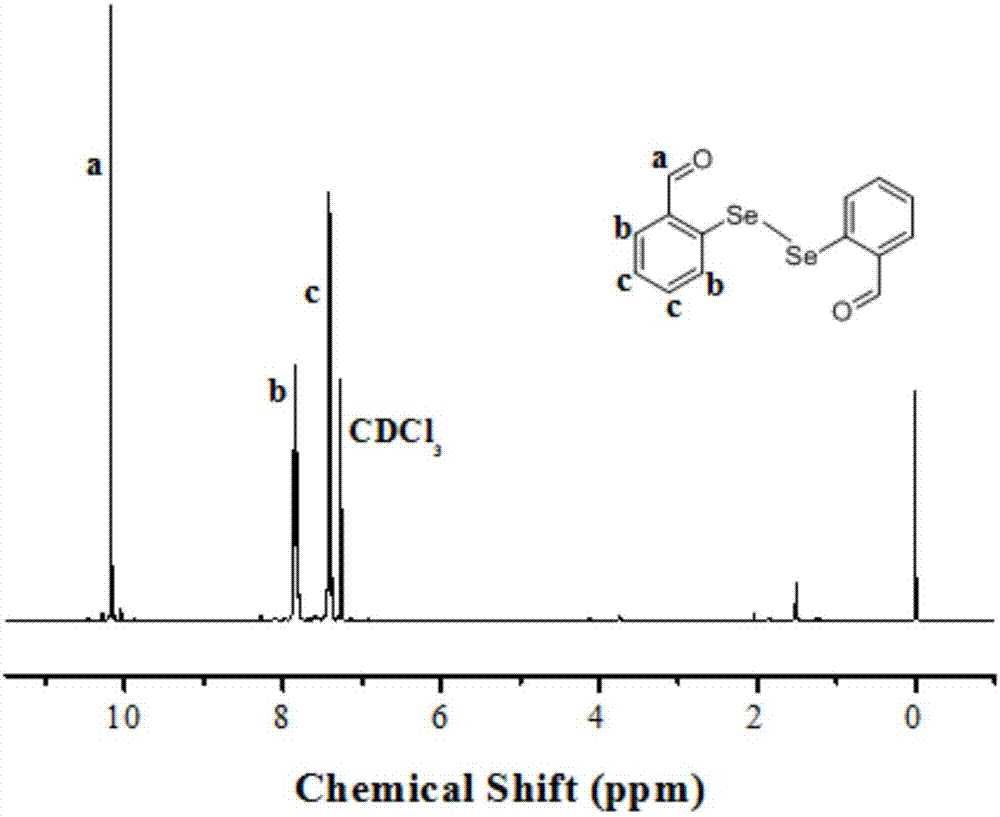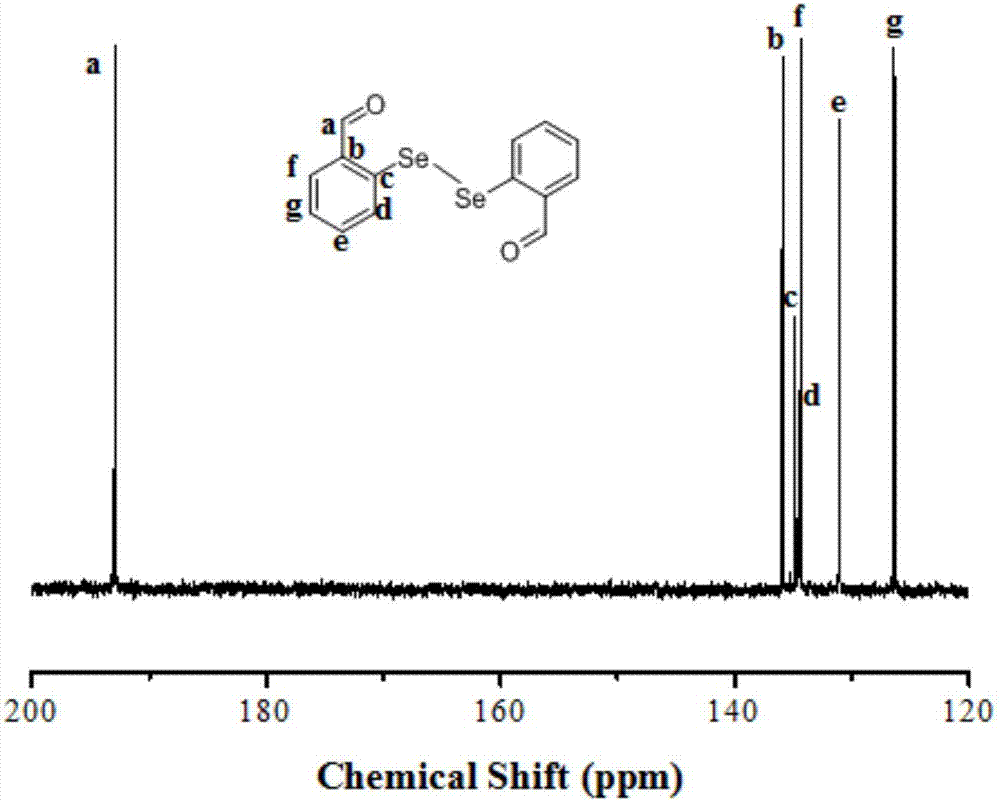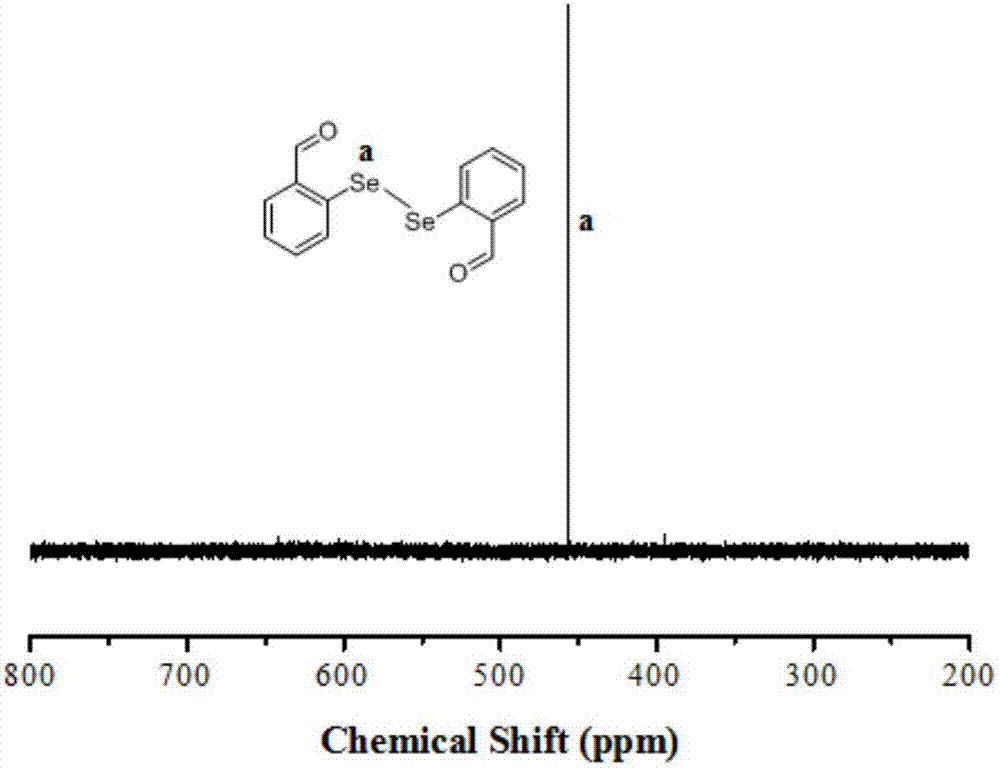Selenium-containing macromolecule fluorescence probe and preparation method thereof
A technology of fluorescent probes and macromolecules, applied in the field of selenium-containing macromolecular fluorescent probes and its preparation, can solve the problems of selenium-containing small molecular fluorescent probes such as water solubility and poor stability
- Summary
- Abstract
- Description
- Claims
- Application Information
AI Technical Summary
Problems solved by technology
Method used
Image
Examples
Embodiment 1
[0051] (1) Synthesis of sodium diselenide:
[0052] Add NaOH (0.4mol) into a 500ml three-neck flask, add 150ml of water to dissolve it, add selenium powder (0.4mol) and tetrabutylammonium bromide (2.5mmol) under stirring to obtain a reaction solution. Add sodium borohydride (0.85mol) and sodium hydroxide (0.04mol) into the beaker, add 5ml of water to dissolve them, and add them to the above reaction solution in batches, after the addition, react at room temperature for 1h, Then the temperature was raised to 90°C for 0.5h. Pour the reaction solution into a 500ml beaker, let it cool naturally and place it in the refrigerator, filter the precipitated solid with suction, wash it with acetone and ether in turn, and the reddish-brown needle-like solid obtained is the product sodium diselenide. The reaction scheme of above-mentioned reaction is as follows:
[0053]
[0054] (2) Synthesis of 2,2'-dialdehyde diphenyl diselenide
[0055] First, the 50ml three-necked flask was vent...
Embodiment 2
[0069] Steps (1)-(3) are the same as in Example 1.
[0070] (4) Weigh Se-BODIPY (0.2mmol) into a 5ml ampoule at room temperature, add PEGMA 500 (Molecular weight is 500g / mol, 12.0mmol), refrigerated and pumped three times, sealed after deoxygenation, stirred and reacted under a high-pressure mercury lamp for 48h, and ended the reaction. Dissolve in 1ml tetrahydrofuran, precipitate with ether, centrifuge to obtain the polymer, put it in a vacuum oven for drying, and obtain a selenium-containing macromolecular fluorescent probe, which is named PPEGMA 500 . The reaction scheme diagram of above reaction is as follows, wherein, n=280:
[0071]
[0072] Figure 8 for PPEGMA 500 It can be seen that there is an obvious signal peak at 2.58ppm, which belongs to the methyl peak after Se-BODIPY participates in the polymerization; there is a signal peak at 5.99ppm, which belongs to the pyrrole after Se-BODIPY participates in the polymerization. The hydrogen signal peaks at 7.06-7.2...
Embodiment 3
[0077] The 50ml three-necked flask was ventilated with argon for ten minutes, and the air was removed. Then, o-bromobenzaldehyde (20mmol), sodium diselenide (40mmol) synthesized in Example 1 was added in the 50mL three-necked flask, and 20mL tetrahydrofuran was added as a solvent to keep the air Argon, after stirring at room temperature for 2h, the temperature was raised to 90°C and the reaction was refluxed for 40h. After natural cooling, wash with water and extract with ethyl acetate (20mL×3 times), take the organic phase and dry it with anhydrous sodium sulfate, rotary evaporate, remove the solvent and then separate by silica gel column chromatography (eluent PE:EA=3:1 ) to obtain a yellow solid, which is the product 2,2'-dialdehyde diphenyl diselenide.
[0078] The three-necked flask was vented with argon for two hours, and the air was removed. Then, 2,2'-dialdehyde diphenyl diselenide (1 mmol) was added to a 50-ml three-necked flask, 25 ml of dry dichloromethane was added...
PUM
 Login to View More
Login to View More Abstract
Description
Claims
Application Information
 Login to View More
Login to View More - R&D
- Intellectual Property
- Life Sciences
- Materials
- Tech Scout
- Unparalleled Data Quality
- Higher Quality Content
- 60% Fewer Hallucinations
Browse by: Latest US Patents, China's latest patents, Technical Efficacy Thesaurus, Application Domain, Technology Topic, Popular Technical Reports.
© 2025 PatSnap. All rights reserved.Legal|Privacy policy|Modern Slavery Act Transparency Statement|Sitemap|About US| Contact US: help@patsnap.com



